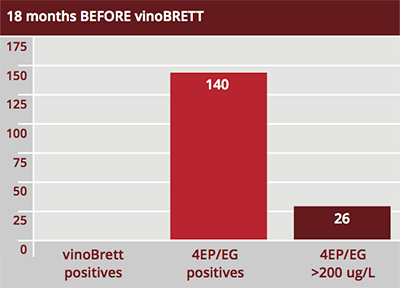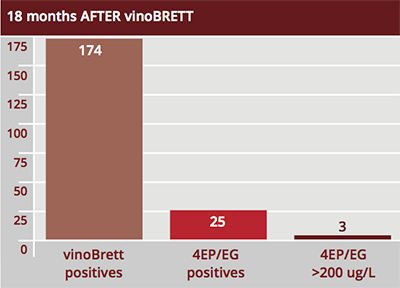Wine Testing
Preserve the value of your wine
Proactive monitoring for wine spoilers from juice to bottle
Spoilage organisms can be a silent threat to wine quality
Brettanomyces, Pediococcus and Lactobacillus are inherent in winemaking, yet their presence may not be recognized until the effects produce a damaging impact on wine quality. Traditional testing methods to monitor for these microbes require long wait times with inconclusive results, and other molecular methods are expensive and complex. Given these limitations, winemakers lack accurate, rapid detection to manage spoilage organisms proactively at the winery.
BOTTLESAFE expands the game-changing VERIFLOW® wine portfolio, creating a full grape-to-glass solution for wineries of any size, producing either white or red wines. The innovative suite includes assays for the wine-making process (VINOBRETT), fermentation (VINOPAL), and now, bottling (BOTTLESAFE).
Proven platform delivers accuracy, speed, and sensitivity
Invisible Sentinel’s wine quality tools are powered by Veriflow - a game-changing platform technology that combines proven diagnostic principles for microbial detection and innovative, first-in-class scientific approaches. Veriflow technology is AOAC International Certified for foodborne pathogen detection. The winery suite of products was developed specifically for winemakers in conjunction with Jackson Family Wines, and has been validated and implemented by a variety of award-winning, quality-centric wineries around the world.
Integrates easily throughout the winemaking process
Invisible Sentinel’s products for winemakers provide onsite detection of spoilage organisms at any stage of the process, from juice to bottle. Veriflow technology offers unparalleled performance with no compromise in ease-of-use or affordability.

Fermentation
Detect organisms early, at low thresholds, even in juice or young wines

Racking
Pinpoint problematic lots or barrels for quarantine and proactive management

Topping wines
Minimize the potential for cross-contamination during topping

Finishing
Identify potential contaminants at the critical blending stage

Bottling
Provides a definitive quality assurance measure before product release for bottling (verify final filtration)
Proactive management to preserve quality and value
With the power of Veriflow technology, it is now possible for winemakers to conduct routine, proactive testing throughout the winemaking process to obtain accurate information about the presence of unwanted microbes at any time. Proactive quality management mitigates the risk of producing wine that fails to meet standards and results in lost value.
Detecting spoilage organisms early and at low levels enables Management:
- Less intrusive methods, including temperature modulation, higher SO2, lower pH
- Minimal labor requirements
- Ability to isolate tainted lots early to minimize cross-contamination
- Minimal to no impact on wine quality and value
Economic Impact: Negligible ($)
Detecting spoilage organisms late and at high levels requires Remediation:
- More intrusive methods, such as filtering, blending, additive treatments
- Labor-intensive processes such as sterilization, barrel access, barrel cleaning
- Increased costs and hassles in the event of cross-contamination
- Potential for bulking out or discarding wine
Economic Impact: Significant ($$$)
Wine quality tools
Proactive Brettanomyces Monitoring - Case Study
Background on the winery
- A large California winery producing 1.5 million cases annually
- Maintains 100,000 barrels in the winery
- Until July 2014, used sensory detection as primary method for Brett detection
- Used confirmatory 4EP/4EG testing via external lab service
Rationale for implementing vinoBRETT
- Quick and easy to test in-house
- Accurate, sensitive and selective PCR testing
- Results in less than 4 hours, with less than 30 minutes of prep time
- Less expensive than external lab service PCR testing
Results: 18 months pre- and post-vinoBRETT implementation
In the 18-month period preceding vinoBRETT implementation, there were 140 incidents of wine lots infected with Brettanomyces byproducts 4EP/4EG, with 26 at elevated levels >200 ug/L. In the 18-month period following proactive monitoring with vinoBRETT, the winery experienced a significant reduction in wine lots infected with Brettanomyces byproducts (4EP/4EG). There were only 25 incidents of positive 4EP/4EG wine samples, with only 3 at elevated levels >200 ug/L. There were approximately 2000 tests run in each time period.
- 80% reduction in 4EP/4EG incidents
- 90% reduction in high level 4EP/4EG incidents


vinoBRETT enabled early detection to protect wine quality
The proactive approach to testing resulted in earlier detection of Brettanomyces, with the ability to intervene while the threat is low, prevent cross-contamination, avoid costly remediation and potential loss of wine quality and value. Total costs for testing during this time period were reduced by > 40% as a result of conducting in-house testing compared to sending out samples for 4EP/4EG testing.








